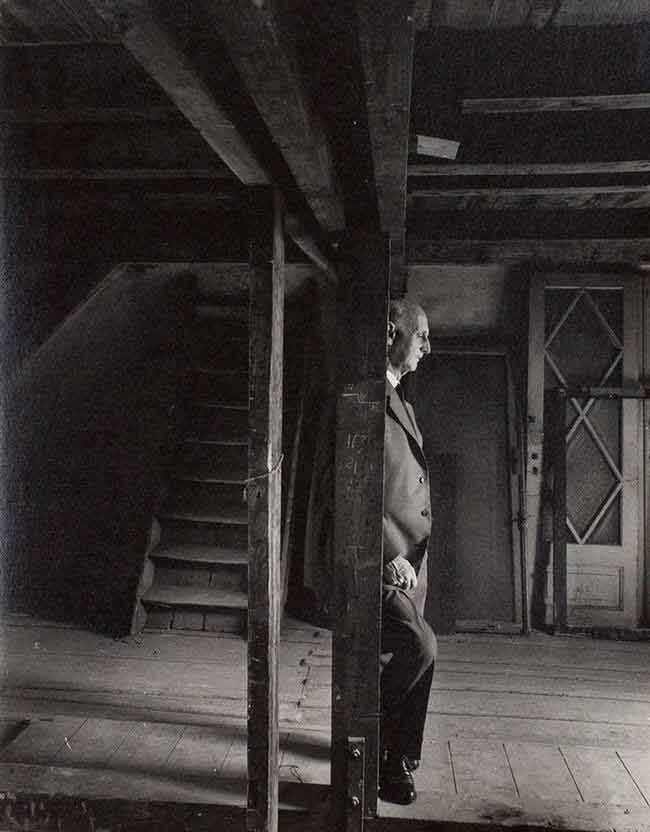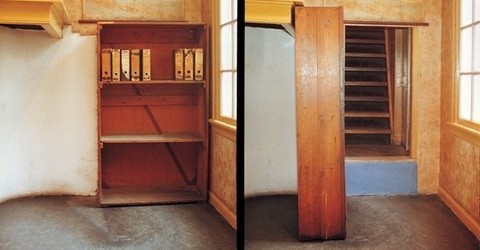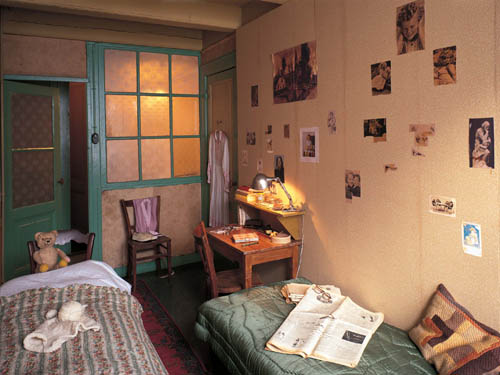
Otto Frank, businessman and father of Anne Frank. Amsterdam, 1960. Arnold Newman/Courtesy of Howard Greenberg Gallery.
As our group made their way toward the bookcase, there was quiet chatter. I was among a small group of people visiting the Anne Frank House just before noon.
On my first visit to the Netherlands in December 1993, a visit to the Anne Frank House was a must. Like visiting the Mona Lisa in 1985, I didn’t want to just read about a place or a thing if I could see it in real life. I have been fortunate enough to visit twice. The details of those two encounters have never left me.
As you walk up to the bookcase, it seems unlikely anyone would have been fooled by it. The bookcase lies at the end of a short hallway. A circular stairway, known as the helper’s staircase lead up to the bookcase. The area had not been in use for about two years by the time the Franks arrived, so maybe people didn’t think anything of it. I questioned how easily people were fooled.
Our guide said a few words. There was more quiet chatter. Our guide opened the bookcase. Chatter ceased as the creaking bookcase caused the group to fall silent. We hesitated to take a step in. Suddenly, it was all real. Words didn’t matter. Nothing is going to prepare you for what you are about to experience.
There’s an uncomfortable silence that walks into the attic with you. You did not ask it to come, but it is there anyway.
The stairs are almost immediately in front of you. They are extremely steep, so much so that you need to climb up them on the balls of your feet. Your entire foot will not fit on each step, making you feel like you are climbing a ladder rather than steps. The Secret Annex, or het Achterhuis, was behind that bookcase. It contains several rooms.
Otto, Edith, and Margot shared a room that was 13 feet long by 8 feet wide. Anne and the dentist Friedrich “Fritz” Pfeffer shared another room that was 13 feet long by 6 feet wide . There was also a small bathroom. Upstairs, the dining room was also the living room, the kitchen and the bedroom for Hermann and Auguste Van Pels. Their son, Peter Van Pels, had a small room, which was really a small hallway leading to the attic for himself. While this sounds like a large area. It is remarkably small.
I was struck by the size of the attic. Movies and television have a way of distorting size. It was so much smaller than I had envisioned. eight people were forced to live here. They could not leave. They could not make a noise. To do either meant certain death, not only for them, but six other people. They lived this way every single day.
The size made me think back to the complaints Anne had in her diary. I suddenly understood the reason Peter would spend time upstairs in the loft. It was the only place he could be alone, have a private moment, be away from the constant contact of the others.
Although the pictures of celebrities, royalty, and art Anne pasted on the wall were covered in plexiglass, I instinctively put my hand up on the wall. When I was fourteen, I, too, had put pictures on my walls of people I admired. I ran my hand across the wall, off the plexiglass and for several inches more. I imagined how the little girl was growing, replacing childish pictures with more adult art and how she was slowly learning who she was in this tiny, cramped hiding place.
There is a beauty in the silence that is almost indescribable. On our travels, we speak and point to things we want to show the people we are with. A discussion about the particular thing typically follows. In the attic, I would tap Paul on the arm, point to what I was looking at. He would nod and look at it, too. We remained silent. No one told us we had to be. We just were. The other people in our group did the same. An unwritten rule? Perhaps. We just didn’t feel speech was required or a necessity here.
The silence consumes you as you feel the need to be as quiet as Anne, Margot, Peter, and everyone else who hid here. The reality of the life here forces the uncomfortable silence to take center stage. The sadness, the sacrifices, the hope is here, too. You feel it all at once and you have to find a way to deal with the emotional weight of a place where people thought they would be okay, and they were, for a little while.
I was looking down into the courtyard to see if I could pick out the chestnut trees Anne wrote about when I heard them. As the bells of the carillon in the Westerkerk Protestant church’s Westertoren rang, a knot formed in my throat. My anxiety increased. The bells broke the silence. I stood still, continued staring out the window, and listened to their sound.
Arnold Newman, the photographer who took the picture of Otto Frank above, said it was the saddest photograph he had ever taken. He, too, heard the bells.
As I began to take the photographs the bells of the nearby church began to peal and he turned to me to explain that these were the bells that his daughter wrote about in her biography. At this point he could contain himself no longer and he began to weep…and so did I.
And everything feels connected. The experience is humbling, solemn, fascinating, moving. You will feel more than you have ever felt, yet leave empty. The fragility of life is ever-present in the chaos of hope and evil.
I studied the map of Normandy that Otto used to mark the advancement of Allied troops. Blue, red, and black pins marked troop movements and the hope of an end to the war and to hiding.
I touched the area where the children had marked their growth, a familiar scene in many families. In two year’s time, Margot grew one centimeter while Anne grew thirteen. A joyous occasion at any other time. Now, it marked progress toward death.
These children would never be afforded the opportunity to become adults. Their lives reduced to a few birthday gifts, an array of papers, and a diary. Their lives still touch us in this place. Deep within your soul, you can feel them even today.
You notice the small things here. The binoculars Anne used to watch the neighbors, the design of the small frosted glass windows in the bathroom, the faucet in the bathroom, and the Delft blue toilet with birds inside the bowl.
Reading The Diary of a Young Girl was required for all eight graders when I was in school. We watched the film starring Millie Perkins as Anne Frank after. As a young New Yorker, I was vividly aware of the Holocaust, not just of what happened to the Jews, but what was done to the Poles, the Gypsies, the LGBT community, and the physically and mentally challenged.
Even armed with this knowledge, seeing where they hid and the handwritten diary of this little girl, it is an overwhelming experience that is hard to describe. It cuts to the heart of humanity – the good and the evil – and you will leave a changed person.
The Annex is not only a testament to a little girl’s hope of survival, but of the life of a disparate eight people, hoping to survive the brutality of humanity. The weight of their hope, and of their death, weighs on the spirit as you touch the things they touched and stand where they stood.
The only picture I took that day was of the toilet. I’m not sure if we were even allowed to take photographs. In the middle of this somber experience, a beautiful blue and white toilet rests. I took a step back, said, “Huh,” and took a picture. It made me smile. For that, I was thankful. I bought a postcard of the bookcase.
I was honored to be able to visit and stand where the innocent stood. My visit has remained with me and is a constant reminder to be a better person, to not tolerate injustice, no matter how small. Their story allows us to remember the horror mankind is capable of. It is a tangible connection to the past that allows us to remember that they are more than ink on paper, more than characters in a book.
In spite of everything I still believe that people are really good at heart.
I hope that Anne was able to keep a hold of that thought, even at the end, because it is still true. There are good people out there, even if the ones in 1945 were too late in getting to her.
The church bells continue to ring. The hope of a little girl disappeared, but we have her memories and her dreams. Maybe we can find the hope within ourselves to not be cruel, to have empathy, and to make the world a better place so that no more children have to endure a life where death is a welcome outcome to life.




aj
Thanks for taking us there through your writing. This is not ancient history, this was only decades back. Sorrow & reflection of how we can be better.
Irene
It’s such a moving place that I would highly recommend it to everyone who has the opportunity to go. Hopefully, those who visit will reflect and take away the idea to be a better person, no matter how good they think they already are.
elsie riley
AT the present time I and two other friends spend 1 hour a week reading the story of the diary of Anne Frank in italian…..truly a book of endurance and faith. Your description has made me realize how fortunate I am to live in the United States and have so much!. I was touched with your words and pictures……I too believe that most of the world is kind and good and that mankind will survive….and am blessed not to have had to live the lives of the Franks and all those who perished in the Holocaust!. April 2023